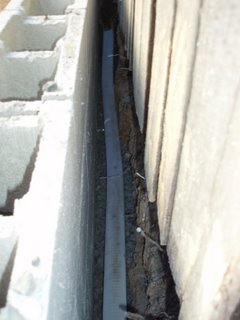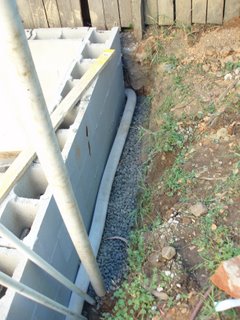The retaining walls are core-filled (23 June 2006)
Before core-filling the walls, I had to set up an ag-drain behind the walls, to ensure that any excess water that is collected behind the walls is taken away and does not start putting pressure on the structure. To do this, I laid some blue-metal at the base, and then placed the drain material over it, covering it again to the top of the wall with additional blue-metal. The drain was then connected to the storm-water drain. Before I did this last step, I also screwed some plastic material (typically used to make garden borders) to the fence, to avoid grass and roots coming through and interfering with the structural integrity of the walls.
Once this was finished, I core-filled the retaining walls. To do this job, I had to puchase several bags of cement, hire a cement mixer, and use a bunch of the road base that I (clearly) purchased too much off. It took me a whole day to mix the concrete and pour it inside of the walls, but the job is finished.
A word of warning: if you ever decide to do a job like this, get yourself a GOOD pair of working gloves. I used garden gloves, and they had tears after half a day. By the end of the day, my hands were severely bruised and very sore!
Once this was finished, I core-filled the retaining walls. To do this job, I had to puchase several bags of cement, hire a cement mixer, and use a bunch of the road base that I (clearly) purchased too much off. It took me a whole day to mix the concrete and pour it inside of the walls, but the job is finished.
A word of warning: if you ever decide to do a job like this, get yourself a GOOD pair of working gloves. I used garden gloves, and they had tears after half a day. By the end of the day, my hands were severely bruised and very sore!

The (electric) cement mixer I hired to do the job

Retaining wall at the end of the job - doesn't it look good?

Ag-drain behind the retaining wall on left side
 Ag-drain behind the water-feature wall
Ag-drain behind the water-feature wall
